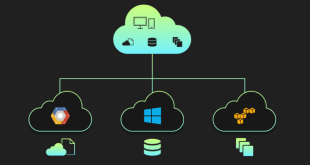In the ever-evolving landscape of cloud computing, businesses are continuously seeking ways to optimize their IT infrastructure. One of the most promising approaches that have gained momentum in recent years is the adoption of hybrid cloud solutions. The emergence of hybrid cloud has revolutionized the way organizations approach cloud computing by combining the best of both public and private clouds. In this blog, we will delve into the rise of the hybrid cloud, exploring how it unlocks synergy in multi-cloud strategies, and why it has become a game-changer for businesses worldwide.
The Hybrid Cloud Defined
The hybrid cloud is a strategic blend of public and private clouds, creating a unified environment that allows seamless data and application portability. In simple terms, it empowers businesses to use a combination of on-premises resources, private cloud services, and public cloud services from providers like AWS, Azure, or Google Cloud. This versatile approach ensures that businesses can leverage the advantages of each cloud model while mitigating their respective drawbacks.
The Driving Forces Behind Hybrid Cloud Adoption
Flexibility and Scalability: Hybrid cloud architectures offer unparalleled flexibility, enabling businesses to scale their infrastructure up or down as needed. This adaptability is particularly crucial for organizations with fluctuating workloads or those looking to accommodate growth.
Data Security and Compliance: While public clouds are renowned for their efficiency and cost-effectiveness, certain industries have stringent data security and compliance requirements. The hybrid cloud allows businesses to keep sensitive data on their private cloud while utilizing the public cloud for less sensitive workloads.
Cost Optimization: The hybrid cloud model enables businesses to optimize costs by utilizing public cloud resources for non-critical operations, while core applications and data remain on a private cloud, reducing overall infrastructure expenses.
Disaster Recovery and Business Continuity: By leveraging both public and private clouds, organizations can build robust disaster recovery solutions that ensure business continuity even during catastrophic events.
Key Components of Hybrid Cloud Architecture
A successful hybrid cloud setup relies on several key components that work together seamlessly:
Private Cloud Infrastructure
The foundation of the hybrid cloud is the private cloud infrastructure, which is either owned and managed by the organization or a dedicated third-party provider. This component ensures data security, control, and high-performance computing capabilities.
Public Cloud Services
Public cloud providers offer a wide array of services, such as virtual machines, storage, databases, and AI tools. These services can be easily integrated into the hybrid cloud architecture, enabling businesses to leverage the extensive resources of public clouds.
Hybrid Cloud Management Platforms
To streamline operations and ensure efficient resource allocation, hybrid cloud environments often utilize management platforms that provide a unified view of both private and public cloud resources.
Networking and Connectivity
Effective networking and connectivity solutions are essential for ensuring smooth data flow and communication between private and public cloud components.
Best Practices for Adopting a Hybrid Cloud Strategy
Comprehensive Evaluation: Before embarking on a hybrid cloud journey, businesses should conduct a thorough evaluation of their existing infrastructure, workloads, and security requirements to identify the best approach.
Data Classification and Segmentation: Classifying data based on sensitivity and importance is crucial for determining which data should reside in the private cloud and which can be stored in the public cloud.
Security and Compliance Measures: Implementing robust security measures and adhering to compliance standards are critical when managing data across hybrid cloud environments.
Workload Placement Strategy: Careful consideration should be given to workload placement, ensuring that applications are hosted on the most suitable cloud environment based on performance and cost factors.
Testing and Monitoring: Regular testing and monitoring of the hybrid cloud infrastructure are essential to identify and resolve potential issues proactively.
The Future of Hybrid Cloud
The hybrid cloud is not just a trend; it represents the future of cloud computing. As businesses continue to grow and evolve, their IT needs will become increasingly complex. The hybrid cloud’s ability to provide a flexible, secure, and cost-effective infrastructure positions it as the go-to choice for enterprises seeking to unlock the full potential of multi-cloud strategies.
Final Words
In conclusion, the rise of hybrid cloud solutions has been a game-changer for businesses worldwide. By combining the strengths of public and private clouds, organizations can achieve enhanced synergy in their multi-cloud strategies. Flexibility, scalability, data security, and cost optimization are just a few of the benefits that the hybrid cloud offers. As technology advances and the demand for agile, secure, and scalable infrastructure grows, the hybrid cloud is poised to become the backbone of modern business operations.
Commonly Asked Questions
1. What is the difference between hybrid cloud and multi-cloud?
Hybrid cloud involves the integration of private and public clouds, creating a unified environment. In contrast, multi-cloud refers to using multiple public cloud providers without integrating them into a single environment.
2. Is hybrid cloud suitable for small businesses?
Yes, hybrid cloud solutions can be tailored to suit the needs of small businesses. It allows them to combine cost-effective public cloud services with the control and security of a private cloud.
3. How does hybrid cloud ensure data security?
Hybrid cloud solutions enable businesses to keep sensitive data on their private cloud, which is subject to their security protocols. Less sensitive data can be stored in the public cloud, benefiting from the provider’s robust security measures.
4. Can a company switch to a hybrid cloud from an all-private or all-public cloud setup?
Yes, companies can transition to a hybrid cloud model from an all-private or all-public cloud setup. However, careful planning and data migration strategies are necessary for a seamless transition.
5. Is hybrid cloud adoption complex?
While hybrid cloud adoption requires careful planning and evaluation, it is not inherently complex. With the right strategy and the assistance of experienced cloud providers, businesses can smoothly integrate hybrid cloud solutions into their infrastructure.
 webfily
webfily



